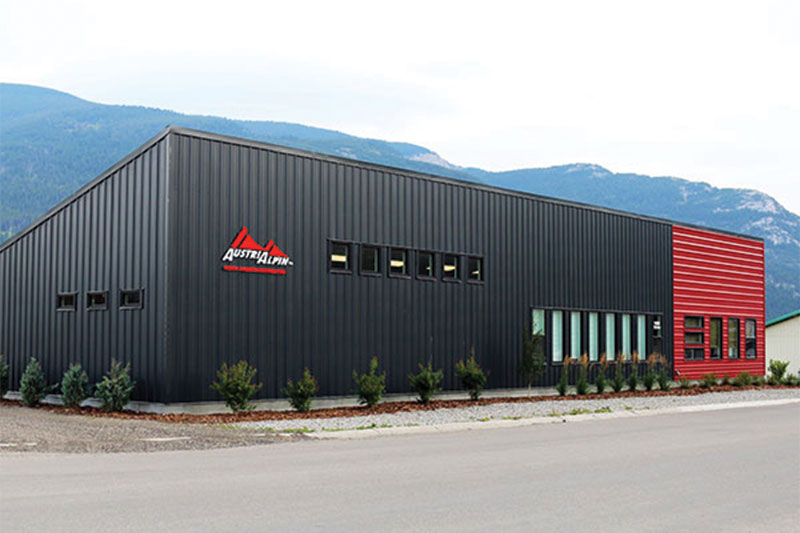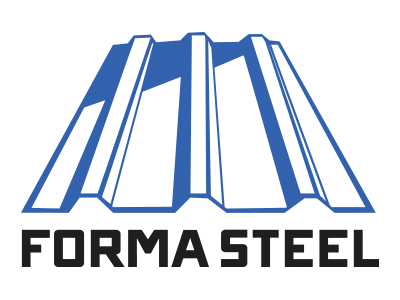GLOSSARY OF TERMS
Steel Terminology Made SimpleAir Barrier:
A membrane in the building enclosure that controls air leakage into and out of the structure
Caulk:
A material used to seal joint and seams to prevent leaks
Chalk Line:
A line used as a point of reference to ensure straight or aligned installation of product, made with a tool that creates a line of
chalk when the string is snapped against a surface
Cladding:
The exterior layer of a building that provides the structure protection against the natural elements including wind, water and
vapour. Cladding is also used to improve the appearance of a building
Closure:
A piece of material, most often foam or acrylic, to close the gap between the panel and the deck. This material helps to keep dust, water and insects from getting into the structure
Cricket:
A ridge structure designed to divert water, ice and snow around the high side of a chimney
Deck/Decking:
The material between the supporting structural components (trusses and joists) and the roofing material. The two most common types of decking are plywood and OSB (oriented Strand Board)
Dormer:
A roofed structure that typically contains a framed window that protrudes from the plane of a sloped roof.
Drip Edge:
Metal trims, usually shaped like an “L” installed at the edges of a roof to allow water run-off to drip away from the fascia and into the gutter.
Eaves:
The lower horizontal edge of the roof that overhangs the face of a wall, it is the typical location of soffit.
End-Lap:
The overlapping edge of one piece of a panel or flashing ends, and another starts. The joints overlap to prevent water leakage.
Fascia:
A vertical band under a roof edge that is visible from ground level.
Felt:
A protective layer made to breathe yet repel water that is installed underneath the final roof layer
Field Cut:
A cut made to material ‘in the field’ as opposed to where it was manufactured. Cuts are made with snips, shears and blades.
Flashing:
Thin pieces of trim installed around joints, intersections or protrusions in a roof that prevent water from seeping in at those
places (ex: chimneys, valleys, dormers, vent pipes, walls, etc.)
Gable:
The triangle part of the wall that is between the edges of intersecting sloped roofs.
Gable Roof:
The classic, most commonly occurring roof shape in cold parts of the world. Two roof sections slope in opposite directions and meet at the ridge.
Gambrel Roof:
Also known as a “Dutch Roof”, a gambrel roof contains two sloping planes of different pitches on each side of the ridge. The lower plane has a steeper slope than the upper.
Girt:
A horizontal structural part within a framed wall that provides lateral support to the cladding primarily to resist wind.
Hip Roof:
A type of roof where all four sides slope downwards to the walls at the same pitch. A hip roof does not contain a gable.
Ice Dam:
What forms when snow on the roof melts, runs down to the overhang and freezes. The best way to prevent ice dams is to ventilate the roof properly, so it doesn’t warm the snow on top. It is also best practice to install an ice and water shield layer over the decking and under the metal roofing to prevent leaks from excessive snow melt.
Intake Ventilation:
Usually installed in the soffit or along the eaves, the intake ventilation
allows for cool air to enter the attic space, driving warm, moist air out of the exhaust vents.
Lean-to Roof: (Also known as mono-pitched
roof, pent roof, shed roof or skillion roof)
A roof with one slope that is built against a higher wall
Liner Sheet:
The interior layer of a double skin roof or wall that acts as the air and vapour barrier as well as create an aesthetic interior finish
Major Rib:
The section of the metal panel that measures the highest vertical distance from the flat of the profile
Mansard Roof:
A four-sided gambrel-style hip roof characterized by two slopes on each of its sides. The lower slope is at a steeper angle than the upper and often contains dormer windows.
Membrane:
A waterproofing component of a roof that is usually made of a flexible material such as rubber, thermoplastic or modified bitumen.
Metallic Coating:
A coating of zinc or aluminum-zinc alloy applied to the sheet steel intended to provide corrosion protection
Minor Rib:
Indentations on a panel that reduce the appearance of oil-canning. The minor ribs are raised higher than the flat of the panel, but not as high as the major rib.
Oil-Canning:
The perceived waviness or buckling effect in the flat area of metal panels.
Open Valley:
As opposed to closed valley roofing (common for shingled roofs), open valley doesn’t allow the intersecting roofs material to cover the valley. In open valley roofing, the two sides of the valley are trimmed along a straight line and leave the valley flashing exposed (open valley always used on metal roofing)
Overhang:
The section of the roof that extends beyond the outer walls of a building and hangs over the edge
Pitch (Slope):
The measurement of how steep a roof is. In roofing, pitch is usually measured /12, for example: a 6/12 pitch means the roof rises 6” for every 12” horizontal run (rise over run).
Point Load:
Is how much load or weight applied to a single point on a weight-bearing part of a structure
Post-Painting:
The process of painting cladding after it has been roll-formed.
Pre-finished:
Metal coils that have been pre-finished have been painted or coated before being delivered to a fabricator
Purlin:
A horizontal beam along the length of a roof that rests on the main rafters intended to transfer the loads from the roof to the principle structural frame.
Rafter:
The structural part of a roof that slopes from the ridge down to the eaves
Rake:
The inclined edge of a sloped roof over a wall from the eave to the ridge
Re-cover (Overlay):
A method of roof installation where the old roof is not removed and the new roof is installed over top
Re-roofing:
When an existing building gets a new roof
Ridge:
The peak of the roof where the intersection of the sloped roofs meet at the very top of the roof. Covered by a ridge cap.
Rise:
The vertical distance from the eave edge to the ridge.
Roof Boot/Master Flash/Pipe Flashing:
An accessory made to seal tightly around small ventilation pipes, plumbing and other vents coming through the roof surface
Run:
The horizontal distance from the center of the ridge to the eaves. Equal to half of the span length.
Snow Guards:
Accessories attached on sloping roofs that inhibit the sliding of snow. Can also be referred to as Snow Cleats or Snow Stops.
Soffit:
The finished underside of the eaves, can be vented or non-vented.
Span:
The horizontal distance from eave to eave.
Strapping (battens):
Wood strips that are nailed to the roof deck or rafters that the metal
roofing is installed on. The space between the deck and the metal roofing that the strapping creates allows for better air insulation of the roof. Installing strapping over an old roof gives the ability to do some leveling on the old roof surface as well.
Structural Quality Sheet Steel:
Sheet steel produced to a published material specification that guarantees minimum material properties
Sub-Girt:
A structural component within the wall cavity that separates the exterior steel cladding from the interior steel liner to create a gap for insulation
Synthetic Underlayment:
A synthetic polypropylene material installed under the metal roof that is UV resistant, slip resistant and self-sealing.
Tear off:
To remove an existing roof
Telegraphing:
A distortion that may occur when a new roof is installed over an uneven surface. This may include screw or clips being made visible in a hidden fastener system. It typically does not jeopardize the performance of a metal roof system.
Thermal Resistance:
The ability of a material to slow the transfer of heat.
Uplift:
When wind causes areas of suction on a roof that create up lift forces and distort the shape of the roof
Valley:
The low intersection of two sloping roof planes that acts as a channel for water runoff.
Vent:
Any device designed to allow air flow through a roof or roof deck.
White Rust:
The white, chalky build-up on the surface of the metal as a result of zinc oxidation caused by an absence of oxygen. This occurs when metal absorbs moisture from humidity or rain. Oxidation can be prevented by applying a vinegar solution or light oil.
Yield Strength:
The maximum stress that can be applied without permanent deformation of the panel.

View Our Complete Line-up of Steel Roofing and Siding Panels
Forma Steel offers 6 Standard Profiles in 29, 26 & 24 Gauge. Along with our FormaLoc and FormaPlank products, we have a roofing and siding solutions for just about every application. Learn more about our line-up of steel roofing and siding panels.


